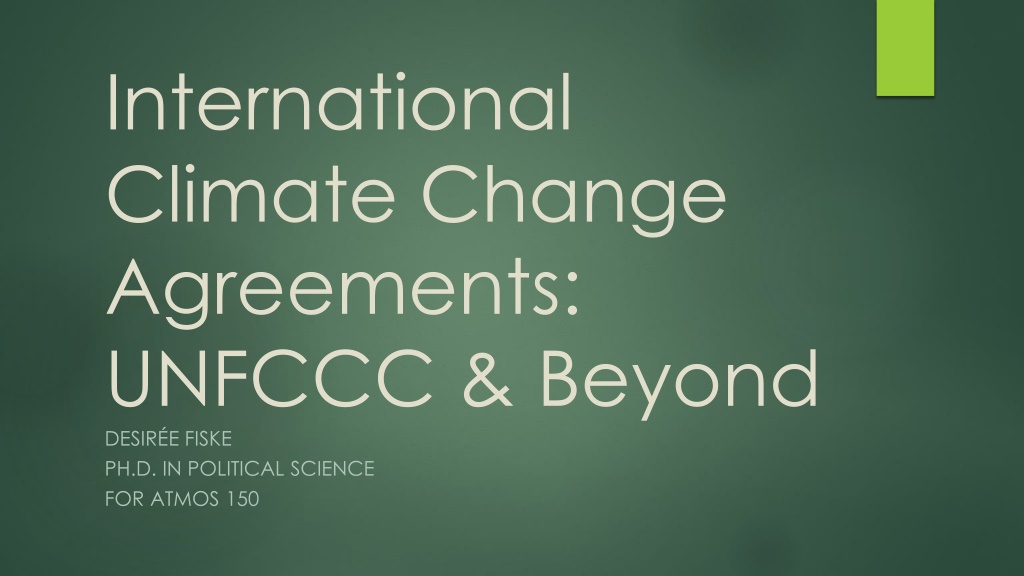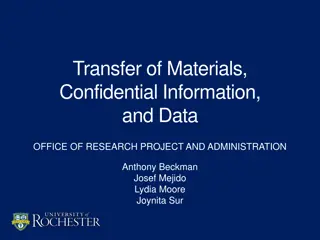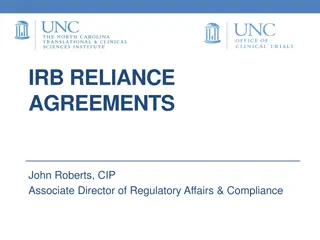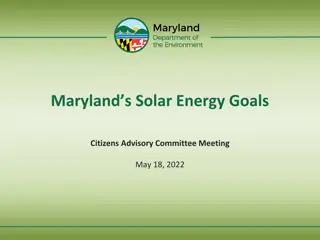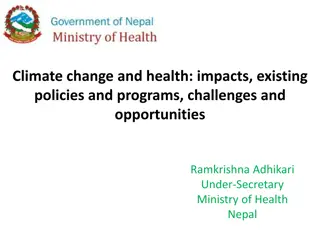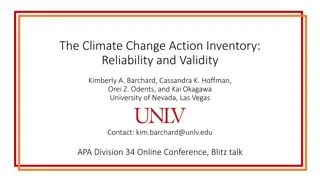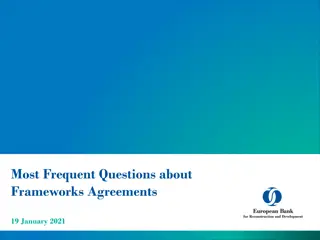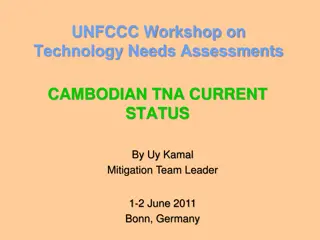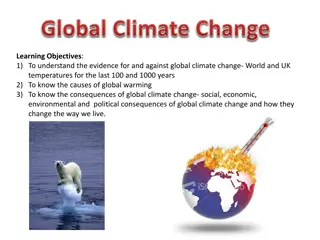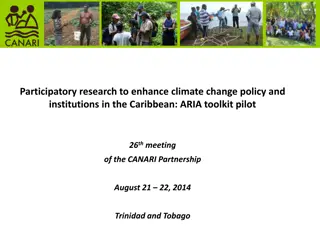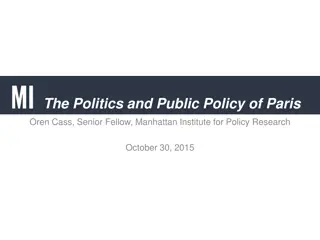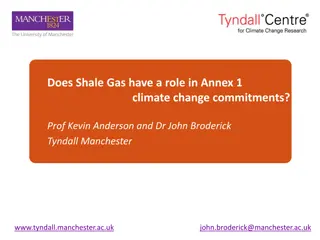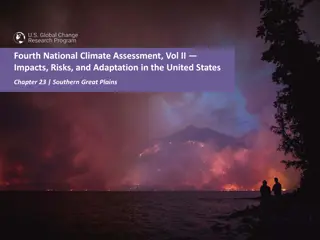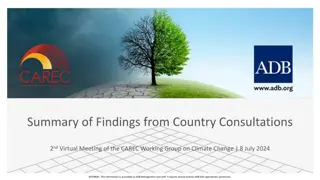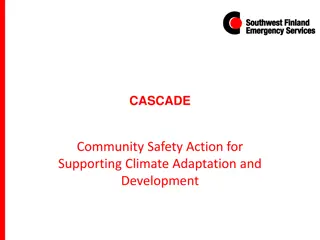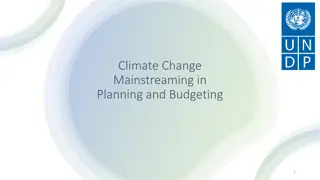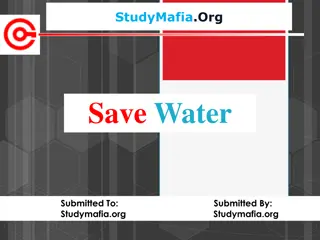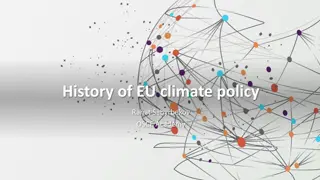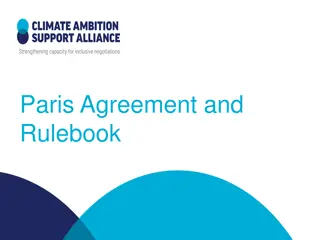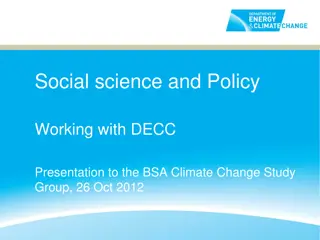Global Efforts and Challenges in Climate Change Agreements
Explore the evolution of international climate change agreements, from the birth of UNFCCC to the success of the Montreal Protocol. Analyze key questions on actor involvement, policy advising, societal needs reconciliation, and scientific knowledge application. Delve into the UN's role, civil society debates, and the mission of UNFCCC amidst a timeline of significant events.
Download Presentation

Please find below an Image/Link to download the presentation.
The content on the website is provided AS IS for your information and personal use only. It may not be sold, licensed, or shared on other websites without obtaining consent from the author. Download presentation by click this link. If you encounter any issues during the download, it is possible that the publisher has removed the file from their server.
E N D
Presentation Transcript
International Climate Change Agreements: UNFCCC & Beyond DESIR E FISKE PH.D. IN POLITICAL SCIENCE FOR ATMOS 150
Think: Take class information and critically analyze: - Are the right actors involved in these agreements/working groups? - Who should be responsible for advising climate change policy? - How do we reconcile social and environmental needs in policy? - Is anything left out in the application of scientific knowledge?
Process and Debates: UN agreements can be binding but the UN is not a government Conventions adopt Countries sign join ratify Then entered into force Multilateralism Civil Society Big debates: environmental justice ; developing (global South) v. Developed (global North) ; social v. economy v. environment
Montreal Protocol (1987): Success of an Environmental Agreement - Global/multilateral effort to reduce CFCs in the atmosphere - SUCCESS! All 197 United Nations members ratified - Still being updated: last update in 2016 on hydrofluorocarbons
And so it begins: Earth Summit, Rio de Janeiro (1992)
UNFCCC is Born - Rio Convention (CBD & CCD too!) - Ratified in March 1994 - COP 1 in 1995 - Meets annually in different cities around the world (never met in the US) - 197 parties - Advised by IPCC
The UNFCCCs Mission The ultimate objective of the Convention is to stabilize greenhouse gas concentrations to a level that would prevent dangerous anthropogenic (human induced) interference with the climate system. ...such a level should be achieved within a time-frame sufficient to allow ecosystems to adapt naturally to climate change, to ensure that food production is not threatened, and to enable economic development to proceed in a sustainable manner. But have they been successful?
Timeline: 2004: COP10, Buenos Aires, Argentina 1990: IPCC 1st Assessment 2005: COP11, Montreal, Canada 1992: Earth Summit 2006: COP12, Nairobi, Kenya 1992: IPCC 2nd Assessment 2007: IPCC 4th Assessment 1994: UNFCCC enters into force 2007: COP13, Bali, Indonesia 1995: COP1, Bonn, Germany 2008: COP14, Pozna , Poland 1996: COP2, Geneva, Switzerland 2009: COP15: Copenhagen, Denmark 1997: COP3, Kyoto, Japan (The Kyoto Protocol) 2010: COP16, Canc n, Mexico 1998: COP4, Buenos Aires, Argentina 2011: COP17, Durban, South Africa 2012: COP18, Doha, Qatar 1999: COP5: Bonn, Germany 2013: COP19, Warsaw, Poland 2000: COP6: The Hague, Netherlands/Bonn, Germany 2014: COP20, Lima, Peru 2014: IPCC 5th Assessment 2001: COP7: Marrakesh, Morocco 2015: COP21, Paris, France 2001: IPCC 3rd Assessment 2016: COP22, Marrakesh, Morocco 2002: COP8, New Delhi, India 2017: COP23, Bonn, Germany 2003: COP9: Milan, Italy
Unanimously adopted in 1997 Marrakesh Accords (2001) - steps towards ratification Didn t enter into force until 2005!! 2006: Clean development negotiations Assistance for developing states; joint implementation starts in 2008 Doha Accord (2012) emission reduction by 2015 2020 Goals were not met! Trials and Tribulations: Kyoto Protocol (1997 - 2012)
Copenhagen Accord High hopes for a new deal COP15, 2009 in Copenhagen Yet again, problems of consensus, exclusion, and tension Only five countries drafted the deal (US, China, India, Brazil, South Africa) Civil society (ex: NGOs) had little involvement and were restricted, even discouraged from attending It was vague! Recognized IPCC report (2 C goal) Not binding; no real commitments - emission reduction targets Up to states to determine emission reductions (Was it bad timing?)
Why is Kyoto considered a failure? 4. US never ratified; countries pulled out; China didn t ratify until 2014 5. Global South did not participate until after Doha 6. Constant process of negotiation and extensions 1. Variations in curbing GHGs 2. Different standards (developing economies concerns) 3. Targets were dependent on economy and emissions Ranges -8% to +10%
Lets start over COP21: Paris Agreement (2015) Why was Paris different? More parties Flexible/sophisticated targets Main targets: Enhanced transparency Technical solutions Financial support for developing countries until 2020 Committed to holding global temperature rise to under 2 C Nationally determined contributions World Wide Views on Climate and Energy with S gol ne Royal, Paris, 2015
COP21: Hope for the Paris Agreement (2015) To Ratify Parties must: 1) Come up with a national plan; 2) Share instruments (methods) on how to execute the plan All eyes on US and China: Joint statement announced September 2016 common but differentiated responsibilities US: Clean Power Plan Entered into force November 4, 2016 To date 143/197 Parties ratified
Looking forward: Paris Agreement U.S.: 2020 target of reducing emissions by 17% below 2005 Reduction of GHG by 26% 28% below its 2005 level in 2025 Annual reduction of 2.3% 2.8% 2050: 80% reduction Clean Air Act; Clean Power Plan; Energy Independence and Security Act China: By 2030: Peak CO2 emissions lower CO2 emissions per unit of GDP by 60% - 65% from 2005 levels (by 2030) increase non-fossil fuels as primary energy source National/regional strategies; and commitments to low-carbon energy system, low- carbon/energy efficient industry, improving building and transportation emissions, increasing carbon sinks, promoting the low-carbon way of life and growth patterns, climate resilience, R&D, financial/policy support, carbon emissions trading, engaging stakeholders, improved GHG record-keeping
Looking forward: COP23 COP23 President: Fijian PM Vorege Bainimarama first time a Pacific Islander has been a COP president. Honoring multilateral commitments from the Paris Agreement The 2017 COP is emphasizing climate adaptation through financial models and technical solutions (embracing science and technology). Changing relations between developed and developing nations? The time for casting blame is over to be sure, it s the developed economies that produce the most carbon emissions. But they are also responsible for most of the gains in technology, science, medicine and other fields that have improved the lives of all people and the technology and learning we will need to solve the crisis.
UN Oceans Conference 2017 First ever Oceans Conference Likely reason for a Fijian President Bainimarama is looking to bridge the Conferences Agenda includes discussions on ocean pollution, sustainable development, and sustainable use of oceans (SDG 14) But also an important opportunity to think about ocean relations to climate change
Discussion: Questions? Responses? Is COP valuable to climate change mitigation and adaptation? Who should do the heavy lifting? How does class material, to date, fit into today s lecture? Thanks!
